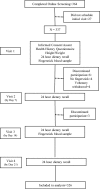The δ13C Value of Fingerstick Blood Is a Valid, Reliable, and Sensitive Biomarker of Sugar-Sweetened Beverage Intake in Children and Adolescents
- PMID: 29378049
- PMCID: PMC6251656
- DOI: 10.1093/jn/nxx017
The δ13C Value of Fingerstick Blood Is a Valid, Reliable, and Sensitive Biomarker of Sugar-Sweetened Beverage Intake in Children and Adolescents
Abstract
Background: Reliance on self-reported dietary intake methods is a commonly cited research limitation, and dietary misreporting is a particular problem in children and adolescents. Objective indicators of dietary intake, such as dietary biomarkers, are needed to overcome this research limitation. The added sugar (AS) biomarker δ13C, which measures the relative abundance of 13C to 12C, has demonstrated preliminary validity in adults.
Objective: The purpose of this investigation was to determine the comparative validity, test-retest reliability, and sensitivity of the δ13C biomarker to detect AS and sugar-sweetened beverage (SSB) intake using fingerstick blood samples in children and adolescents.
Methods: Children (aged 6-11 y, n = 126, 56% male, mean ± SD age: 9 ± 2 y) and adolescents (aged 12-18 y, n = 200, 44% male, mean ± SD age: 15 ± 2 y) completed 4 testing sessions within a 3-wk period. Participants' height, weight, demographic characteristics, and health history were determined at the first session; 24-h recalls were obtained at each visit and fingerstick blood samples were collected at visits 1 and 3. Samples were analyzed for δ13C value using natural abundance stable isotope mass spectrometry. δ13C value was compared with dietary outcomes in the full sample, and in child and adolescent subgroups. t Tests and correlational analyses were used to assess biomarker validity and reliability, whereas logistic regression and area under the receiver-operator characteristic curve (AUC) were used to evaluate sensitivity.
Results: Reported mean ± SD AS consumption was 82.2 ± 35.8 g/d and 329 ± 143 kcal/d, and SSB consumption was 222 ± 243 mL/d and 98 ± 103 kcal/d. Mean δ13C value was -19.65 ± 0.69‰, and was lower in children than in adolescents (-19.80 ± 0.67‰ compared with -19.56 ± 0.67‰, P = 0.002). δ13C values were similar across sessions (visit 1: -19.66 ± 0.68‰; visit 3: -19.64 ± 0.68‰; r = 0.99, P < 0.001) and were associated (P < 0.001) with intake of total AS (grams, kilocalories: r = 0.29) and SSB (milliliters, kilocalories: r = 0.35). The biomarker was able to better discriminate between high and low SSB consumers than high and low AS consumers, as demonstrated by the AUC (0.75 and 0.62, respectively).
Conclusions: The δ13C biomarker is a promising, minimally invasive, objective biomarker of SSB intake in children and adolescents. Further evaluation using controlled feeding designs is warranted. Registered at clinicaltrials.gov as NCT02455388.
Keywords: added sugar; children and adolescents; corn and cane sugar; dietary assessment; obesity; sugar-sweetened beverages.
© 2018 American Society for Nutrition. All rights reserved.
Figures


Similar articles
-
The Carbon Isotope Ratio as an Objective Biomarker of Added Sugar Intake: A Scoping Review of Current Evidence in Human Nutrition.Adv Nutr. 2024 Sep;15(9):100281. doi: 10.1016/j.advnut.2024.100281. Epub 2024 Jul 31. Adv Nutr. 2024. PMID: 39094908 Free PMC article.
-
Influence of an intervention targeting a reduction in sugary beverage intake on the δ13C sugar intake biomarker in a predominantly obese, health-disparate sample.Public Health Nutr. 2017 Jan;20(1):25-29. doi: 10.1017/S1368980016001439. Epub 2016 Jun 14. Public Health Nutr. 2017. PMID: 27297740 Free PMC article. Clinical Trial.
-
Association of δ¹³C in fingerstick blood with added-sugar and sugar-sweetened beverage intake.J Am Diet Assoc. 2011 Jun;111(6):874-8. doi: 10.1016/j.jada.2011.03.019. J Am Diet Assoc. 2011. PMID: 21616200 Free PMC article. Clinical Trial.
-
Evaluation of the Relative Validity and Test-Retest Reliability of a 15-Item Beverage Intake Questionnaire in Children and Adolescents.J Acad Nutr Diet. 2017 Nov;117(11):1757-1766.e5. doi: 10.1016/j.jand.2017.05.011. Epub 2017 Jun 30. J Acad Nutr Diet. 2017. PMID: 28673606
-
New markers of dietary added sugar intake.Curr Opin Clin Nutr Metab Care. 2016 Jul;19(4):282-8. doi: 10.1097/MCO.0000000000000287. Curr Opin Clin Nutr Metab Care. 2016. PMID: 27137898 Free PMC article. Review.
Cited by
-
The carbon isotope ratios of nonessential amino acids identify sugar-sweetened beverage (SSB) consumers in a 12-wk inpatient feeding study of 32 men with varying SSB and meat exposures.Am J Clin Nutr. 2021 May 8;113(5):1256-1264. doi: 10.1093/ajcn/nqaa374. Am J Clin Nutr. 2021. PMID: 33676366 Free PMC article. Clinical Trial.
-
Objective Biomarkers for Total Added Sugar Intake - Are We on a Wild Goose Chase?Adv Nutr. 2020 Nov 16;11(6):1429-1436. doi: 10.1093/advances/nmaa093. Adv Nutr. 2020. PMID: 32805008 Free PMC article.
-
The Carbon Isotope Ratio as an Objective Biomarker of Added Sugar Intake: A Scoping Review of Current Evidence in Human Nutrition.Adv Nutr. 2024 Sep;15(9):100281. doi: 10.1016/j.advnut.2024.100281. Epub 2024 Jul 31. Adv Nutr. 2024. PMID: 39094908 Free PMC article.
-
Dietary biomarkers-an update on their validity and applicability in epidemiological studies.Nutr Rev. 2024 Sep 1;82(9):1260-1280. doi: 10.1093/nutrit/nuad119. Nutr Rev. 2024. PMID: 37791499 Free PMC article. Review.
-
An evaluation of the serum carbon isotope ratio as a candidate predictive biomarker of the dietary animal protein ratio (animal protein/total protein) in a 15-day controlled feeding study of US adults.Am J Clin Nutr. 2022 Apr 1;115(4):1134-1143. doi: 10.1093/ajcn/nqac004. Am J Clin Nutr. 2022. PMID: 35030258 Free PMC article.
References
Publication types
MeSH terms
Substances
Associated data
Grants and funding
LinkOut - more resources
Full Text Sources
Other Literature Sources
Medical
Research Materials

